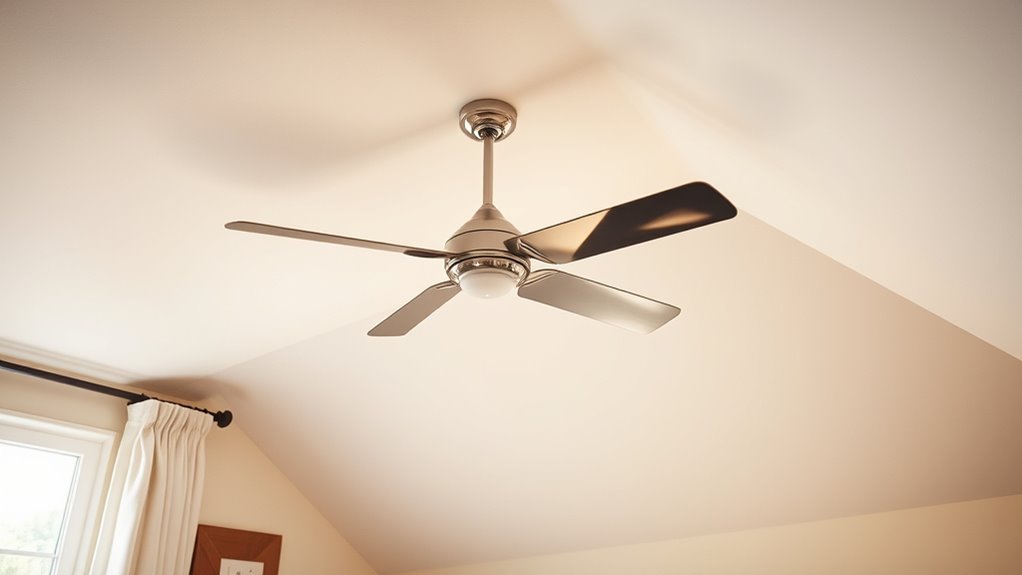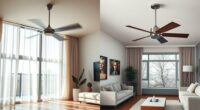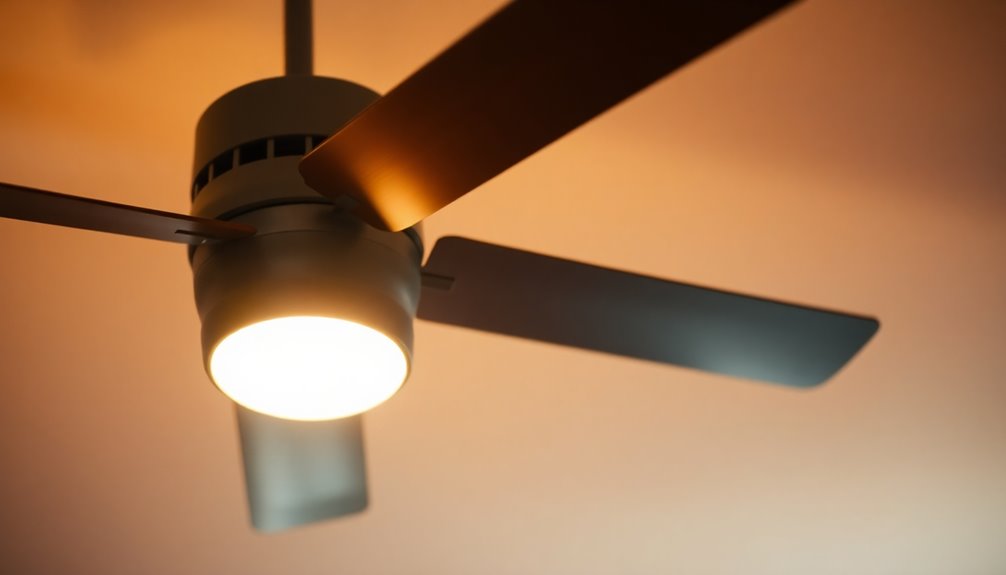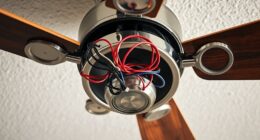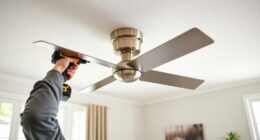Stop installing a standard ceiling fan without an angle mount or a sloped ceiling adapter. Doing so causes wobbling, uneven airflow, and safety risks. Instead, use a fan designed for sloped ceilings with a proper mounting bracket, and guarantee the fan hangs at the right angle. Adjusting the downrod length and balancing blades are also essential for safe, quiet operation. Keep going to discover how to optimize your fan setup for peak performance and safety.
Key Takeaways
- Stop installing standard ceiling fans without an angle mount; use a sloped ceiling adapter for stability and proper airflow.
- Avoid neglecting to adjust the downrod length; ensure the fan hangs at the optimal angle for efficiency and safety.
- Do not ignore the importance of proper fan positioning; place the fan correctly to maximize airflow and reduce wobbling.
- Refrain from skipping routine maintenance; regularly check and balance the fan for smooth, quiet operation.
- Avoid using flat mount brackets on pitchy ceilings; instead, choose compatible angle mounts or sloped adapters designed for sloped ceilings.
Using a Standard Ceiling Fan Without an Angle Mount
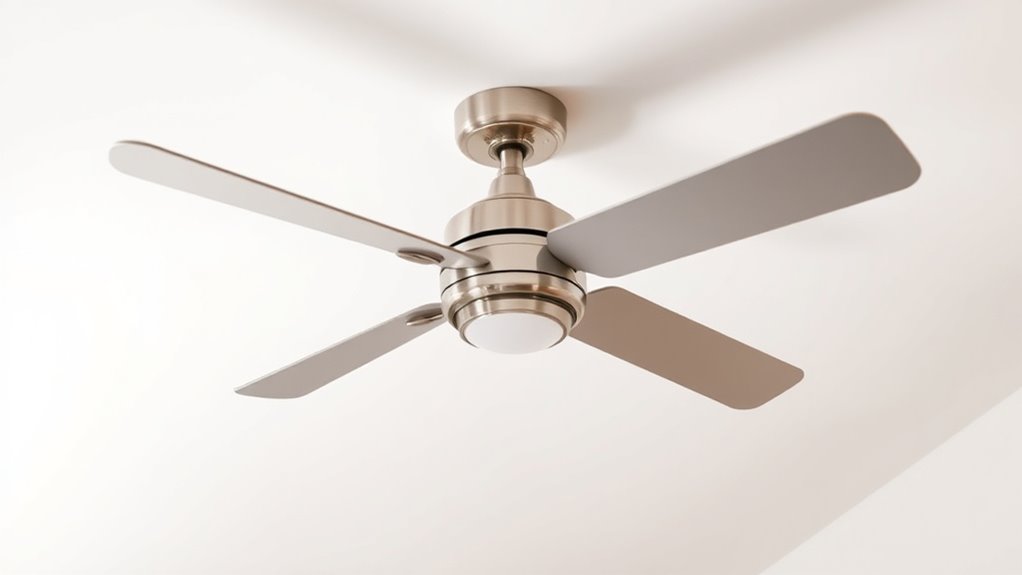
If you install a standard ceiling fan on a sloped ceiling without an angle mount, it can lead to inefficient airflow and potential safety issues. Standard mounts are designed for flat ceilings, so they often don’t match the ceiling’s angle, affecting ceiling compatibility. Without an angle mount, the fan blades won’t hang straight, causing uneven airflow and reducing cooling effectiveness. Additionally, the fan may wobble or become unstable, creating safety hazards. Using a fan that isn’t suited for sloped ceilings can strain the mounting hardware and increase the risk of damage or accidents. To ensure proper operation, always check if the fan is compatible with your ceiling angle or opt for a fan specifically designed for sloped ceilings. This approach guarantees better airflow and safety. Proper mounting techniques and installation guidelines are essential for safe and efficient operation.
Ignoring the Need for a Sloped Ceiling Adapter

Ignoring the need for a sloped ceiling adapter can lead to serious installation issues. Without it, your fan may be unstable or damaged over time, and airflow will be less effective. To avoid these problems, always guarantee you use the correct adapter for your ceiling’s angle. Using appropriate accessories ensures a secure fit and optimal performance of your fan on sloped surfaces.
Risks of Improper Installation
Neglecting to use a sloped ceiling adapter during installation can lead to serious safety hazards and damage. Without proper support, your fan may wobble or loosen over time, risking electrical hazards like short circuits or fires. Aesthetically, an improperly installed fan looks awkward, with gaps or uneven angles ruining your room’s appearance.
| Proper Installation | Improper Installation |
|---|---|
| Secure, level fit | Wobbly, unstable |
| Safe electrical connections | Loose wiring, sparks |
| Clean, neat appearance | Clunky, mismatched look |
| Long-lasting performance | Premature wear or damage |
| Safe operation | Increased risk of accidents |
Ceiling Fan Damage Risks
Failing to use a sloped ceiling adapter when installing your fan can lead to immediate and long-term damage. Without proper adjustment, your fan may experience excessive fan blade wobble, which puts stress on the blades and motor. This wobbling can cause uneven wear and eventually lead to blade damage or detachment. Additionally, the misalignment increases the risk of motor overheating since the fan’s components aren’t properly balanced or ventilated. Over time, this overheating can shorten the lifespan of your fan and potentially cause electrical failures. Ignoring the need for a sloped ceiling adapter compromises both safety and performance, making it essential to ensure your fan is correctly installed for sloped ceilings to avoid costly repairs and maintain ideal function. Moreover, proper installation can also help prevent security vulnerabilities that may arise from faulty wiring or improper mounting.
Inefficient Air Circulation
When you don’t use a sloped ceiling adapter, your ceiling fan may not circulate air efficiently, especially on sloped ceilings. Without proper adjustment, airflow patterns become uneven, causing hot or cold spots and reducing fan efficiency. The fan may push air in a limited direction, failing to mix the room’s airflow properly. This results in less comfort and higher energy costs. To understand this better, consider the following:
| Issue | Effect | Solution |
|---|---|---|
| Improper angle | Disrupts airflow patterns | Use a sloped ceiling adapter |
| Limited air mixing | Reduced fan efficiency | Adjust fan tilt correctly |
| Uneven temperature | Hot/cold spots in the room | Optimize airflow direction |
| Excessive noise | Fan wobbles or strain | Properly install the fan |
| Energy waste | Higher utility bills | Make certain of efficient airflow |
Using an adapter improves airflow, enhances fan efficiency, and maintains comfort.
Installing a Fan With a Flat Mount Bracket on a Pitchy Ceiling
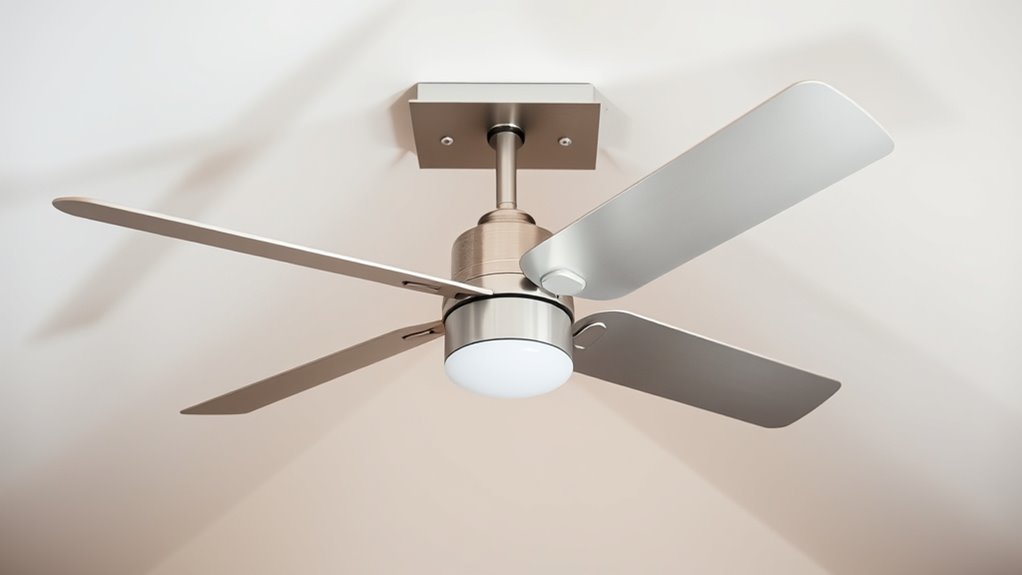
Installing a fan with a flat mount bracket on a pitchy ceiling can be tricky because the bracket may not sit flush against the angled surface. This can lead to unstable mounting and wobbling, reducing the fan’s effectiveness and safety. To address this, consider using an angle mount or a sloped ceiling adapter designed for pitchy ceilings. These accessories help create a secure fit by compensating for the ceiling’s slope, ensuring the fan hangs level and functions efficiently. Avoid forcing a flat mount bracket onto a steeply inclined surface, as this can damage the fan or ceiling. Instead, opt for proper mounting solutions that accommodate the ceiling’s slope, providing a safer, more balanced installation that maximizes airflow and minimizes noise.
Neglecting Proper Fan Positioning for Optimal Airflow
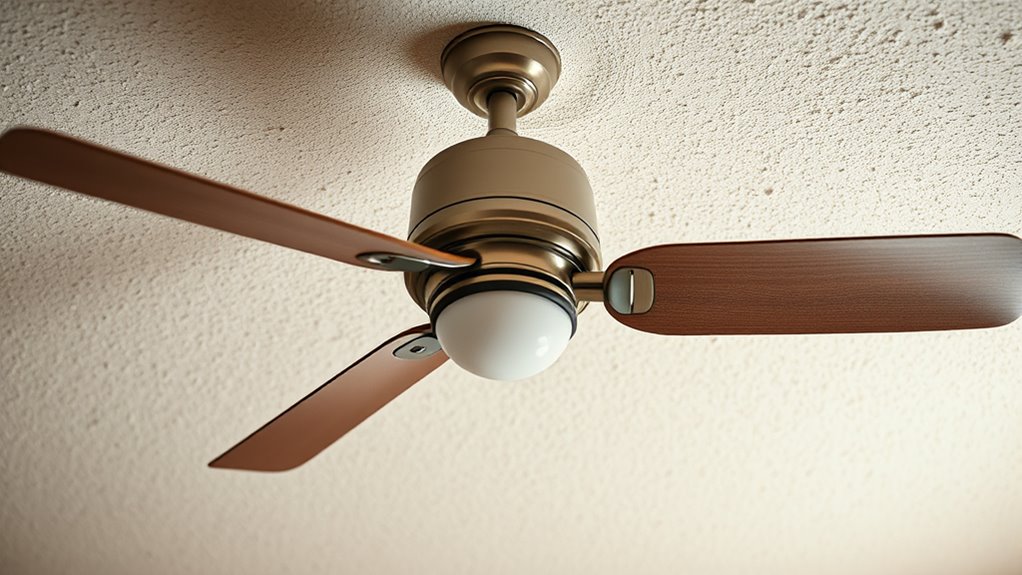
If you don’t position your fan correctly, airflow can become inefficient and uneven. You might find some areas stay warm while others feel chilly, defeating the fan’s purpose. Understanding the best placement and airflow tips helps you get the most out of your sloped ceiling fan. To enhance airflow, consider incorporating farmhouse-style accessories that can help distribute air more evenly throughout the space.
Fan Placement Challenges
Neglecting proper fan placement can considerably reduce airflow efficiency on sloped ceilings. If your fan isn’t positioned correctly, it won’t circulate air effectively, regardless of size or power. Factors like ceiling height and fan size matter: too small, and it won’t move enough air; too large, and it may be overwhelming or improperly aligned. Placement challenges include mounting at the wrong angle or height, which disrupts airflow flow patterns. Consider this table to understand common issues:
| Issue | Cause | Solution |
|---|---|---|
| Fan too low | Ceiling height too short | Mount higher, but within safety limits |
| Fan too high | Ceiling height too tall | Use longer downrods |
| Incorrect angle | Sloped ceiling misalignment | Use angled mounts or adaptors |
| Wrong fan size | Small or oversized fan for space | Choose appropriately sized fan |
Additionally, understanding the airflow patterns on sloped ceilings can help optimize fan placement for better circulation.
Airflow Optimization Tips
Proper fan placement directly impacts airflow efficiency, so it’s worth paying attention to how your ceiling fan is positioned. To maximize ventilation efficiency, ensure the fan blades are angled correctly and spin in a way that promotes even air distribution. On sloped ceilings, adjusting the fan’s tilt and height can help create a consistent airflow pattern, preventing stagnant air pockets. Using a downrod or angled mounting kit can improve airflow direction and circulation. When airflow is optimized, you’ll notice better air mixing, which leads to more comfortable room temperatures and reduced reliance on heating or cooling systems. This not only enhances ventilation efficiency but also results in energy savings. SmartCR AI discoveries, such as optimizing airflow patterns, demonstrate how technology can improve everyday home comfort. Proper positioning ensures your fan works smarter, not harder, delivering comfort and efficiency year-round.
Overlooking the Importance of a Downrod Length Adjustment
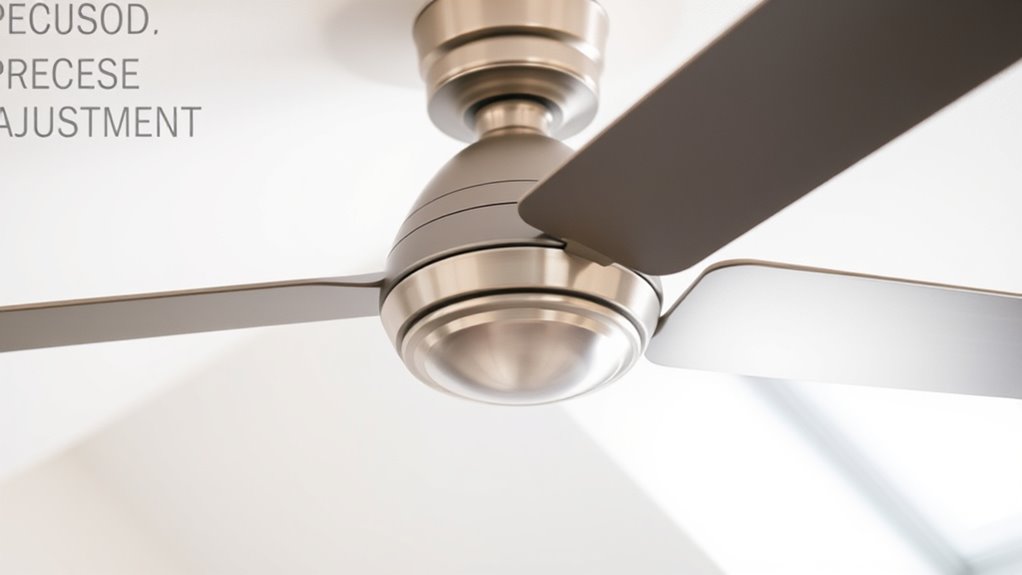
Choosing the right downrod length is essential when installing a ceiling fan on a sloped ceiling, yet many overlook this step. A proper downrod ensures the fan hangs at the ideal angle, especially with an angle mount. If the downrod is too short or too long, the fan blades won’t operate efficiently or may wobble. To determine the correct length, consider the ceiling slope and fan height needed for airflow. Here’s a quick guide:
| Ceiling Slope | Fan Height | Downrod Length |
|---|---|---|
| 15°-30° | 8-9 feet | 12-24 inches |
| 30°-45° | 8-9 feet | 18-36 inches |
| 45°-60° | 8-9 feet | 24-48 inches |
| 60°+ | 8-9 feet | Custom length |
Adjusting the downrod for an angle mount maximizes airflow and safety. Properly selecting the downrod length enhances overall beach town comfort and ensures optimal fan performance.
Failing to Balance the Fan for Safe and Quiet Operation
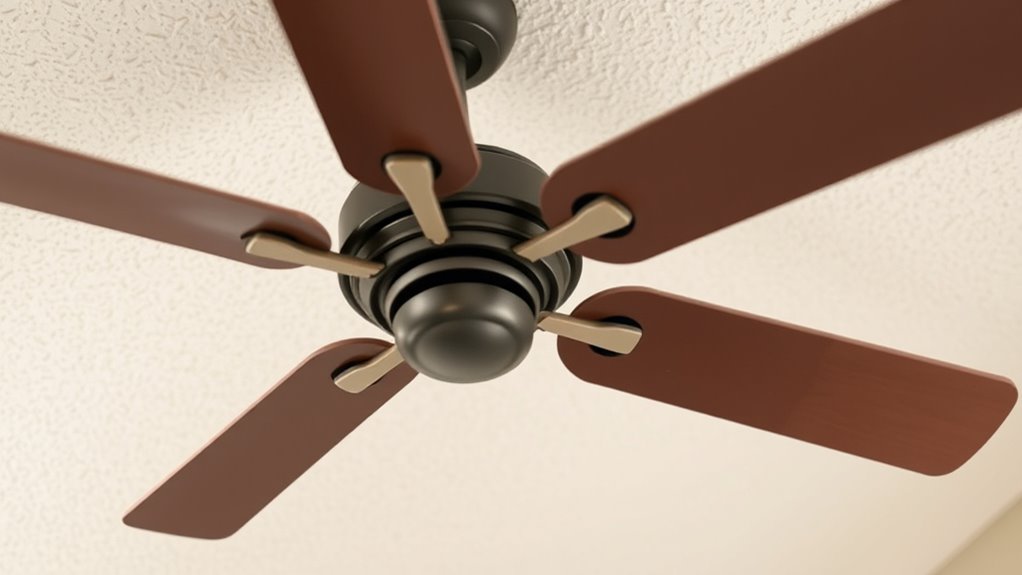
If a ceiling fan isn’t properly balanced, it can wobble, produce noise, and even become unsafe over time. To prevent this, perform a quick balance correction by adding weight to the lighter blades or using a blade balancing kit. This guarantees smooth, quiet operation and reduces wear on the motor. Proper balance not only improves comfort but also enhances safety by minimizing vibration that could loosen mounting hardware or cause the fan to wobble dangerously. Regularly check and adjust the balance, especially after installing or moving the fan. Taking these steps is a simple safety enhancement that prolongs your fan’s lifespan and keeps your space quieter and safer. Don’t overlook balance correction—it’s a key step for peak performance.
Frequently Asked Questions
Can I Install a Ceiling Fan Without Any Angled Mounting Hardware?
You can’t install a ceiling fan without angled mounting hardware if your ceiling slopes. The fan angle requires specialized mounting hardware to guarantee stability and safety. Without it, the fan won’t sit properly or function correctly. Instead, choose the right angled mounting hardware designed for sloped ceilings. This ensures your fan is securely installed, operates efficiently, and looks good, regardless of the ceiling’s pitch.
What Are the Risks of Ignoring a Sloped Ceiling Adapter?
Ignoring a sloped ceiling adapter risks ceiling fan safety and leads to installation pitfalls. Without the proper mount, the fan may wobble, become unstable, or even fall, posing danger to everyone below. You might also damage the ceiling or fan components over time. Always use a sloped ceiling adapter tailored for your setup to guarantee secure installation, prevent accidents, and maintain safe, efficient operation.
How Do I Choose the Correct Downrod Length for My Ceiling?
Think of choosing the right downrod as finding the perfect bridge between your ceiling and fan. Measure your ceiling height to determine the ideal length—generally, the fan blades should hang 8-10 inches below the ceiling. Consider your fan size, ensuring it fits proportionally within the room. If your ceiling is high, opt for a longer downrod; for lower ceilings, a shorter one keeps everything balanced and safe.
Is It Necessary to Balance a Ceiling Fan After Installation?
Yes, balancing your ceiling fan is necessary after installation to guarantee smooth operation and reduce noise. Proper fan balancing improves ceiling fan alignment, preventing wobbling and uneven airflow. You can achieve this by using a balancing kit or calling a professional if needed. Regularly check your fan’s balance to maintain ideal performance and comfort, especially on sloped ceilings where misalignment is more common.
Can a Standard Flat Mount Bracket Be Used on a Sloped Ceiling?
Imagine your ceiling fan as a dancer, poised to glide smoothly. A standard flat mount bracket isn’t suitable for sloped ceilings, as it compromises ceiling fan safety. Instead, you need specialized mounting hardware options like a sloped ceiling kit or an angled adapter. These ensure your fan stays balanced and secure, allowing it to perform flawlessly. Always choose the right hardware to prevent wobbling and maintain safe operation.
Conclusion
To keep your ceiling fan working smoothly on a sloped ceiling, it’s best to follow these tips. Avoid shortcuts like ignoring the angle or using the wrong mount, as they can lead to less effective airflow and potential safety issues. Instead, take the time to choose the right adapter and proper downrod length. This little extra effort guarantees your fan runs quietly and safely, transforming your space into a comfortable oasis—without any unnecessary hiccups.
